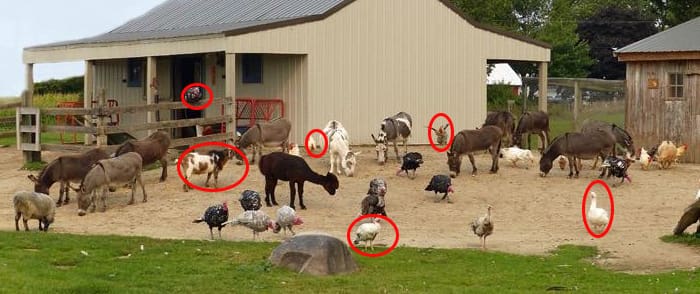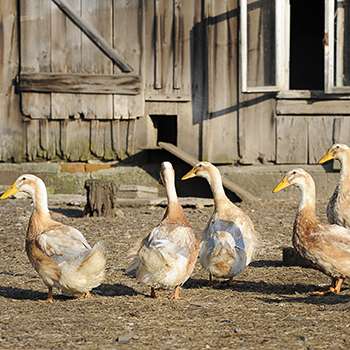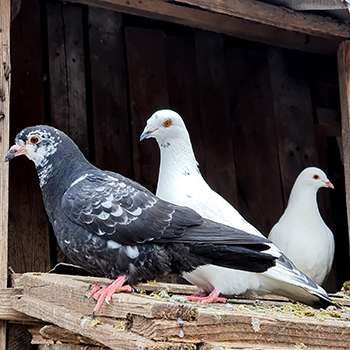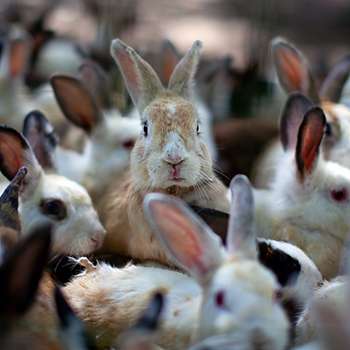What will you eat when the supermarkets run out of food?
Famine used to be something our ancestors faced regularly. But, for most of us living today, the idea of not having anything to eat seems preposterous. Until you hear that the average Venezuelan adult lost 24 pounds of weight in 2018. And, that this is due to the economic collapse brought about by socialism.
Economic collapse is a real possibility, and there are no guarantees that the economy will always stay afloat. This article will deal with the livestock you need to raise and maintain to ensure that you will not be amongst the starving when the collapse happens.
Livestock As A Store Of Value
You can’t eat gold. Nor can you eat your iPhone. And I bet, that if someone is hungry, you could trade an iPhone or gold for a nice juicy steak.
Let’s assume the worst has happened and that the global economy has tanked. Supermarket shelves are growing empty and people are panicking. Money in the bank is useless because there are no goods to buy anyway.
How valuable will the livestock be under circumstances such as these?
Owning food-producing animals will not only allow you to keep eating and stay healthy and strong, but you could also barter excess produce or livestock for other necessities or favors.
Free-Ranging
Animal food and medicine will grow scarce and expensive during an economic crisis. Your best options are to invest in animals that can be readily free-ranged and that need a minimal amount of veterinary care.
The animals mentioned in this article were chosen for their ability to live freely off the land, and are known to be tough.
Production Value Over Time
If you owned two chickens and ate them, you would have food for maybe two weeks. If you lived on two eggs a day, you would have food for years.
The same applies to other animals that lay eggs or produce milk.
When thinking about keeping livestock for an economic crisis, think about the long-term production value, rather than short-term nutritional value.
Male vs Female
Most farmers will tell you that male animals have little value other than serving as food. Oxen are really strong, geldings are temperamentally sound and capons grow nice and big. But even here, there are limits.
Female animals not only produce offspring but may produce eggs or milk for their entire lifespans.
When setting up your herd or flock, you will need only but a few male animals, and as many female animals as you can support. Make sure females are genetically sound and can mate. Only invest in exceptional quality male animals that are proven, breeders.
In all successive generations, keep only the best male animals, eat the rest. Barren females should be eaten, as well as females with poor mothering and nurturing instincts.
Run A Fowl
Most people think turkey or chicken. But I think ducks. Khaki Campbell ducks to be precise. You don’t have to have a dam, but it will be better for your ducks. Dams are also great for irrigating your vegetable patch and keeping fish.
If you can, create islands in the middle of your dams and build shelters for your ducks on these islands. This will assist in keeping predators away from mothers raising small chicks. Plus, they can escape into the water if something does try to catch them.
Khakis lay up to 300 eggs per year, and are known to be great parents. Duck down is excellent insulation and the ducks can also be eaten. Another plus is that bucks are not as destructive to gardens and vegetation as chickens are. Ducks also like eaten slugs.
Something’s Fishy
You can keep fish in the duck pond, or duck’s in your fish dam. No matter which way you go about it, this is a good arrangement. Fish will eat duck-poop, and the nitrates will enrich your water, making it better for irrigation than “clean” water.
Keep a mixture of tilapia, bass, carp, and catfish. Each of these operates in a particular niche, and diversity will keep your dam’s ecosystem robust.
Furthermore, you can feed your fish chopped fowl organs. Minimizing waste and maximizing the fish’s growth.
Pigeons
They have often been described as rats with wings. Which, if you own pigeons, will know is pretty accurate. Not only do they breed like rats, but they can also live off almost nothing.
Keep our pigeons in a safe roost and feed them from time to time. This will keep them from moving elsewhere. Pigeons can be eaten and are great for making stews. I keep quail as ground birds in my coups. Their eggs are great for pickling and a few stuffed quail hit the spot.
The first rock pigeons that came to the USA were kept on ships as food. If they were good enough for your ancestors, they are good enough for you.
Goats
Goats don’t like grass. They prefer weeds, leaves, bark and will nibble on forest debris before laying into the grass. This makes them great to keep on ranches that don’t have pasture.
Goats provide nutritious milk that has an ideal fat content for making cheese. Goats also taste pretty much like sheep, so if you like lamb chops, goats are a great alternative.
But why goats and not sheep. Beside’s the fact that they produce better milk and can live on almost anything, goats outbreed sheep in no time.
Goats will produce offspring three times in 24 months, and most ewes will have twins. Your flock can theoretically increase from 6 ewes to 42 goats in two years. Do the math, that’s a lot of goat meat, my friends.
I recommend having a small flock of Saanen and Boer Goats.
Boer goats are the best meat producers, while Saanen has the best milk. You can breed a Boer Billy to your Saanen for meat production goats, but try to maintain a small group of purebred goats of each type.
Goats are more street-savvy than sheep and don’t get stolen or fall prey to predators as easily as sheep do.
Goats will eat almost anything, they love alfalfa, which is not grass, and can be free-ranged with ease. One problem is that goats don’t respect fences, so your paddock will have to be secure.
Remember to hang a bell around their necks!
Rabbits
Rabbits are an often overlooked source of protein. Californians and New Zealand are two breeds of rabbits that you should consider. They breed like rabbits, grow fast, and can provide a highly nutritious meal.
What I like about rabbits is that they prefer to live in really small and enclosed spaces. Rabbits don’t need to roam and are perfectly content when kept in small cages. Rabit poop can be used as fertilizer, and all vegetable and salad scraps can be fed to your rabbits.
Ceratin rabbit breeds produce good pelts.
Animal-Based Diets
Humans have depended on animals for food since the dawn of our species. Unlike plants, animals don’t have to be cooked to release their nutrients and can be eaten raw. They are also not poisonous and are far more energy and protein-rich than plants.
Organ meats are rich in vitamins and minerals, so be sure to eat them as well.
If you own healthy and varied collection o livestock, you will weather the coming economic crisis in style.
Do You Make These Fatal Mistakes in a Crisis? (Video)
Avoid These 8 Looter-Inviting Things On Your Property
20 Grandma’s Depression Foods We Will Need Soon
How You Can Keep Rodents Out Of Your Garden













Self sufficient Falun gong projects?
What do you think caused Venezuela’s collapse?
He said. Socialism.
Dairy goats do not reproduce that rapidly. If you want to keep your stock in optimal health, you should only breed them once annually. The stress of milking plus reproduction must be taken into account.
Meat goats, OTOH, can and do breed more often.
Also, if you’re just looking for meat, hair sheep breed 3 times in 2 years.
Goats are not EWES – they are DOES. They do not flock; they live in HERDS. Goat meat is significantly leaner than sheep meat, and there is a definite difference in taste.
Goats are also a real pain around equipment because they will climb on anything and everything to get to the top.
Goats, like all ungulates, require proper fencing. You need to protect the goats as well as your equipment and fruit trees, but it’s relatively inexpensive (especially if you frequent auctions), and not at all difficult to install.
Large goats (Saanen, Nubian, etc) can be easily kept behind 4′ woven wire fencing. Be sure to disbud, though, because free-ranging goats can get horns stuck in almost any fencing, and if you don’t find them right away, the result will be unpleasant. DO NOT use barbed wire with goats. An udder can easily be torn if they try to get through the barbed wire fencing.
If you still have electricity in a TEOTWAWKI situation, one hot wire run along the top of the fence is a deterrent to persistent bucks.
Goats are lovely creatures, but you have to tune into their mindset and needs.
Many people overlook the goose. on the farm, we had half a dozen Grey geese. the matriarch was large and old. and I should add a formidable watchdog. Woe to anyone who didn’t belong. Human or animal. her honk was loud and wouldn’t stop as long as she was upset. usually by anyone she didnt know. even people she knew would be treated to her display and a nip from a sharp beak. they live long. sometimes outliving family dogs. they don’t require much attention and get along with chickens, ducks, or other farm animals. they have sharp eyesight and very good hearing it makes them valuable as watchdogs. Unlike dogs that can be too friendly a goose won’t. so even a friend or neighbor will be announced. because so many people who are not familiar with geese are intimidated when confronted by them. so should someone try to Sneak up on you they will become the victim they spread their wings to make themselves larger and charge very quickly taking many off guard, and choosing to flee. Regular geese can be short-tempered but usually flee when people come close. another choice is the swan. these don’t fit in too well but will protect any water on the property. Make sure what you are buying because the young dont look any different than other geese. better to get a full grown mated pair to raise your own.——— I, Grampa